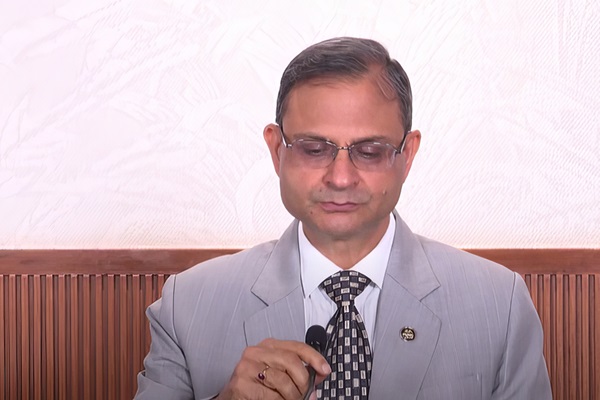.png)

Kalyan Ram, a financial journalist, co-founded Cogencis and now leads BasisPoint Insight.
June 6, 2025 at 3:09 PM IST
The Reserve Bank of India’s latest policy surprised not in content but in delivery. A 50-basis-point cut in the repo rate, a 100-basis-point reduction in the cash reserve ratio, and a sudden pivot to a “neutral” stance came as a single, disorienting package. The central bank’s communication strategy, once regarded as the bedrock of its credibility, was left exposed.
Monetary policy, especially in a large and complex economy like India’s, is as much about managing expectations as it is about altering interest rates. This is why central banks, from the US Federal Reserve to the European Central Bank, invest significant effort in shaping their language. Every word, every pause, every emphasis is intended to signal direction.
When Governor Sanjay Malhotra said at the press conference that he believes in “action, not words,” he missed the point: words are action in central banking, words when chosen well and delivered appropriately while retaining flexibility and nudging the market towards its desired outcomes
The rate cut itself was not the issue as the sharp fall in headline inflation, global uncertainty, and subdued investment activity could well justify continued modest easing. What jarred was the concentration of decisions, the sequencing, and the shift in tone. A 100-basis-point cumulative rate cut since February, followed by a CRR reduction injecting ₹2.5 trillion into an already surplus system, and capped with a stance change that signalled a pause, felt abrupt rather than calibrated.
This is not merely a question of optics as the liquidity environment today is flush. Banks are already sitting on excess funds with few quality lending opportunities. Injecting more liquidity does not necessarily spur investment when income growth is weak and credit appetite is limited. Instead, it risks creating conditions for financial repression.
Banks will likely be forced to lower deposit rates, not because funding costs have structurally declined, but because they do not want to absorb more liabilities they cannot deploy efficiently. Also, high liquidity will push banks towards higher-yielding assets, whether or not aligned with long-term credit fundamentals. The result is familiar: mispricing, misallocation, and financial instability.
When capital exceeds demand, markets chase returns—reflecting momentum rather than fundamentals. Early signs are already visible in money market rates and speculative equity flows. This is not a healthy backdrop for long-term investment-led growth.
More concerning is the message about institutional judgment. Rarely in recent memory has the RBI reversed its stance so quickly following a significant easing move. Conventionally, a shift to “neutral” would precede such action, signalling that the central bank was entering a new phase. Here, it followed the rate cut, implying that the easing cycle may already be over. That might be the case. But it should have been communicated with greater subtlety and sequencing, not bundled into a single policy announcement.
The real puzzle is why the RBI chose to restrict its own flexibility. In an easing cycle, the central bank’s influence is often strongest when it retains a mild bias, letting the market price in further cuts. Forward guidance works best when it builds expectations while preserving room to manoeuvre. In abandoning that balance, the RBI has surrendered an important lever just when global conditions demand agility and caution.
Governor Malhotra’s analogy about playing on the front foot to knock the ball out of the park might appeal to cricket fans. But central banking isn’t T20. It is a long-format contest where discipline matters more than flair. A central banker is not a pinch hitter. He is the wall: managing risk, absorbing pressure, steadying the field and not just deliver sixes to excite spectators.
Markets do not object to rate cuts but they object to inconsistency. When a central bank departs from its own signalling, or abruptly shifts from measured ambiguity to aggressive action, it invites more volatility. This is especially hazardous when global financial conditions remain fragile, geopolitical tensions unpredictable, and fiscal space limited.
Inflation may be under control now, aided by favourable base effects and commodity price corrections. But core inflation remains sticky, and food inflation has a history of turning rapidly. Declaring victory over inflation, as the governor did in his Hindi remarks, is premature. Central banks are not tasked with celebrating outcomes. They are meant to anticipate risks and pace their responses.
It is also very basic that if the economy is expected to grow at 8%, inflation will not remain at 4%. A fast-growing economy invariably generates price pressures through demand for labour, energy, food, and housing. Ignoring this trade-off suggests a troubling detachment from economic fundamentals.
This unbalanced policy setting also complicates India’s macroeconomic stance. While fiscal policy remains conservative, monetary policy now appears to be doing all the heavy lifting. Growth ambitions are understandable, but liquidity-driven accelerations without structural support from income or investment are rarely sustainable. The central bank’s responsibility is not to underwrite GDP numbers. It is to ensure those numbers are built on a foundation that is credible and lasting.
None of this is to argue that the RBI’s intentions are wrong. The logic of frontloading support while inflation is benign is sound. But effective monetary policy is about more than intent. It requires timing, balance, and the ability to speak without saying too much. Central banks earn trust gradually and can lose it quickly. With India’s macroeconomic narrative gaining traction globally, the RBI cannot afford to let its signalling become the weak link.
Some of the most experienced observers of monetary policy are struggling to characterise this decision. That, in itself, is a warning. The RBI used to be known for its understated style and strategic opacity. Now, it seems to be in a rush to act boldly. That shift is neither reassuring nor necessary.
What the economy needs now is a steady hand, not a flurry of improvisation. In central banking, the most effective tools are often patience and restraint. And at times, the most powerful message is silence.




